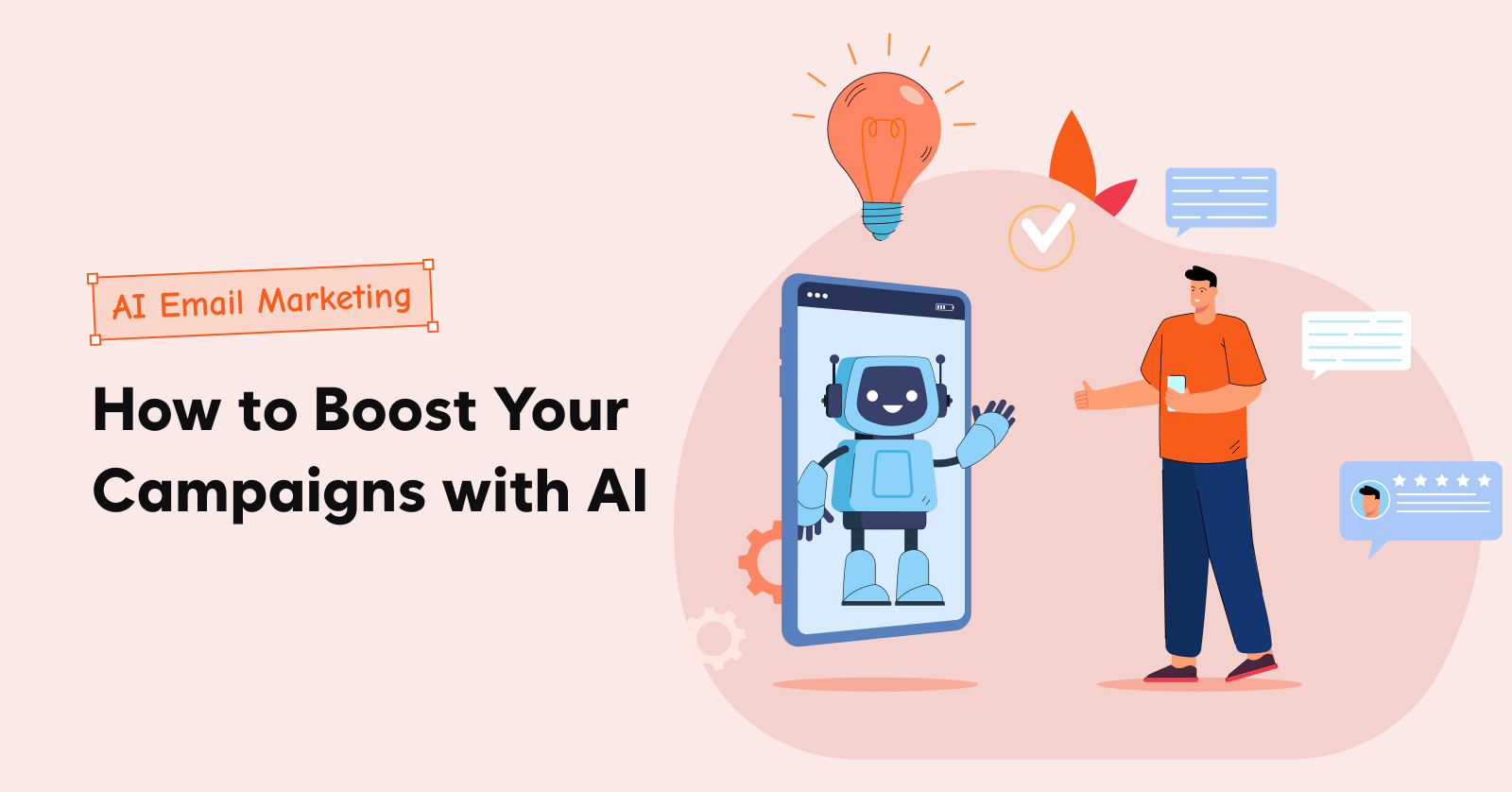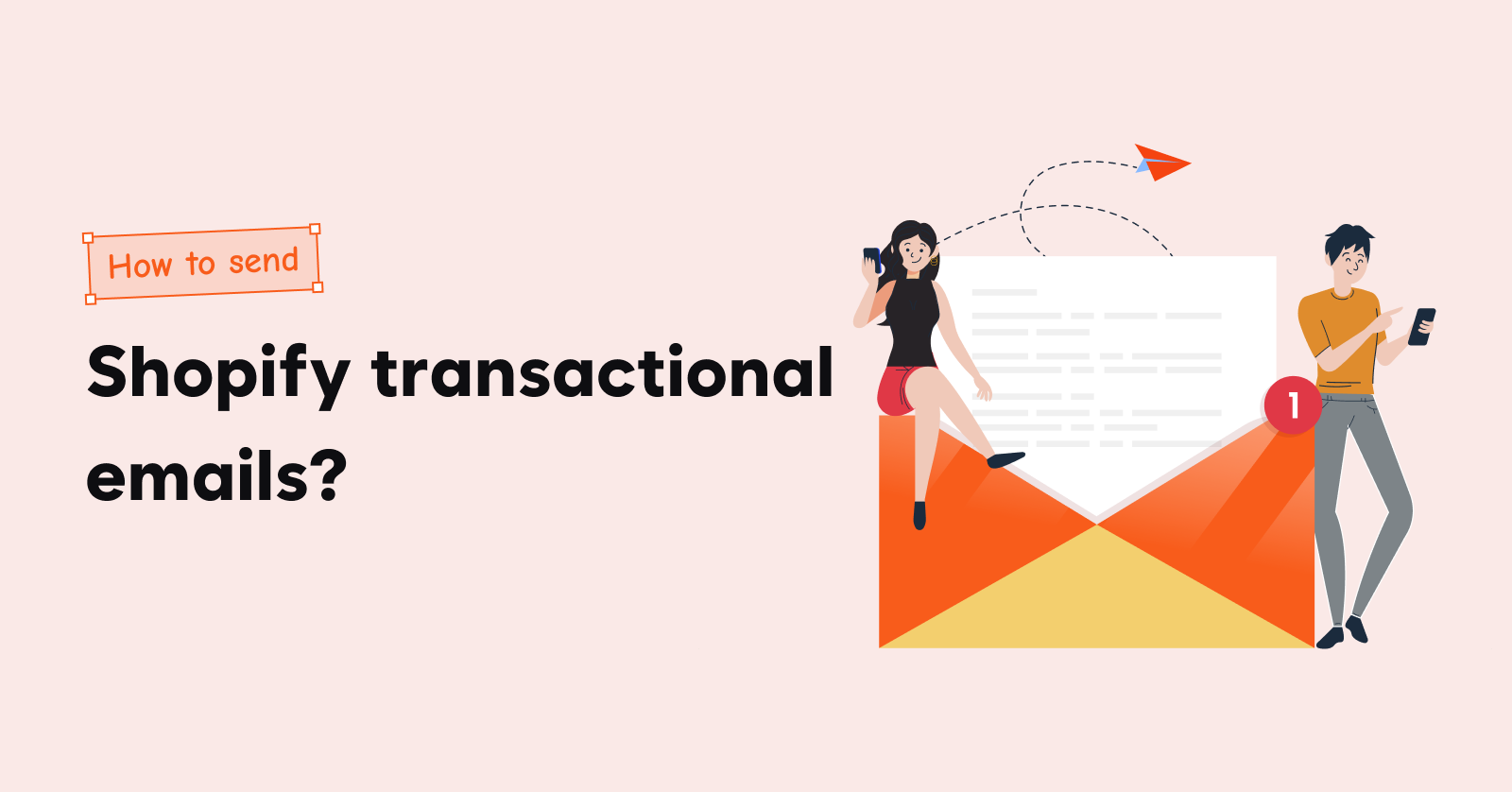With a good email drip campaign, you can turn cold leads into eager customers simply by addressing their needs with a series of timely emails.
By nurturing relationships gradually, these campaigns ensure that your leads hear from you at just the right moments, increasing relevance and conversions.
Implementing a drip email campaign effectively can transform a list of contacts into engaged customers, making it a critical strategy for anyone serious about building lasting relationships with customers.
In this blog, we break down what an email drip campaign is, the best email drip campaign examples, how to create one in simple steps, and the best practices to get the most out of them.
Let’s dive right in.
Send automated email drip campaigns that are triggered based on customer behavior and well-timed intervals with Retainful.
What is an Email Drip Campaign?
An email drip campaign is a series of automated emails sent out at predefined times or triggered by specific actions taken by recipients.
The content of each email in the sequence is planned to build upon previous messages and lead the recipient toward a final goal, such as making a purchase.
Here are the components of a drip campaign:
- Trigger events: These are actions performed by users that initiate drip campaign emails. Common triggers include user sign-ups, purchases, or cart abandonment.
- Segmented customers: An automated drip email campaigns target specific segments of your customers based on their behaviors, preferences, or demographic information to ensure the content is relevant.
- Wait time: Time intervals between emails are strategically set based on the behavior and expected decision-making process of the segment.
- Scheduled emails: These are the backbone of the campaign, with each email scheduled to be sent out at an optimal time following the trigger event.
How many emails should be in a drip campaign?
The ideal number of emails in an automated drip email campaign can vary depending on your objectives, but a sequence of 3 to 5 emails is effective for most of it
Why Send Drip Email Campaigns?
Best drip email campaigns build interest with every email, and gradually, these connections grow into strong relationships – and maybe even customers. It’s about consistency and timing. That’s why drip campaign emails hold an important place in email marketing.
Here are the 4 benefits email marketing drip campaigns bring to your marketing efforts.
- Effective lead nurturing
Not every lead is ready to convert immediately. Best drip email campaigns allow you to nurture the leads by sending a series of email newsletters that gradually guide them through the buying process.
This helps in warming up the leads by providing them with relevant information and solutions, slowly moving them closer to conversion. - Automation saves time
Once the email automation is set up, drip campaigns run automatically. This saves you a considerable amount of time and resources, as you don’t have to manually send out each email in the automated email drip campaign.
Automation ensures that communications are sent out at the optimal time without any additional effort from your team. - Consistent engagement without overwhelming
Automated email drip campaigns are designed to provide information in small, manageable doses, which prevents overwhelming your subscribers while keeping them engaged over a longer period. - Personalization at scale
Email drip campaigns can be highly personalized based on the data you have about each recipient. This could include their name, past behaviors, or specific interests.
Email personalization makes the messages more engaging and can significantly improve open and click-through rates.
5 Essential Email Drip Campaign Examples
Drip email campaigns can be a versatile tool, enabling you to engage with customers through carefully timed, relevant communications.
Here are the essential email drip campaign examples, their purpose, and the sequence of emails to send.
1. Welcome email drip campaign
A welcome email drip campaign is often the first series of emails a new subscriber receives after signing up for your service or newsletter.
- First email: – Sent immediately after registration, this email thanks the subscriber for signing up.
- Second email: Key features or benefits of your product or service.
- Third email: Send useful information related to your industry or products.
Here is a welcome drip campaign workflow:
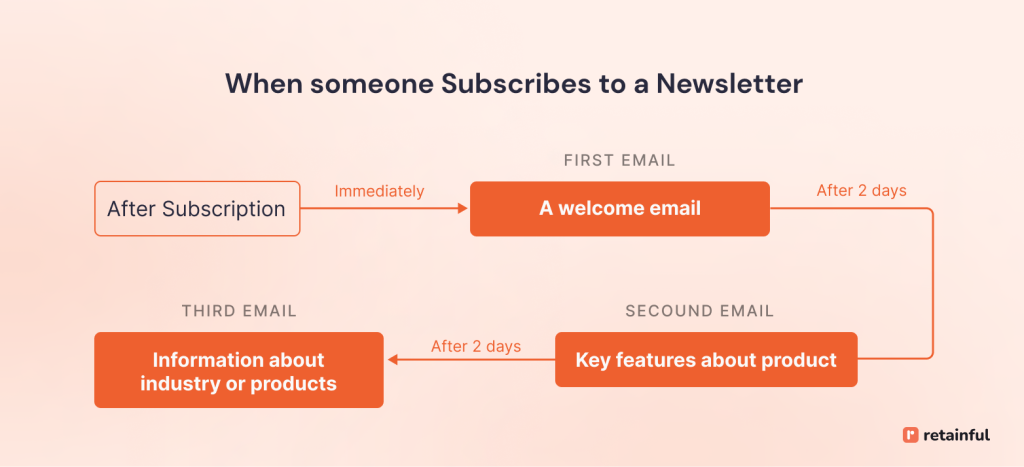
2. Lead nurturing email campaign
Lead nurturing emails help build a relationship with potential customers by maintaining regular contact.
Through this email campaign example, you can communicate about your product’s features, how to get the most out of those and build trust and rapport with prospects.
Here is the series of emails to send in this drip email campaign example:
- First email: Provide educational content like a whitepaper on a specific topic, follow up with related articles, or a webinar invitation.
- Second email: Share case studies or success stories demonstrating how your product or service has helped others
- Third email: Soft sell with a special offer
Here is an email drip campaign template:
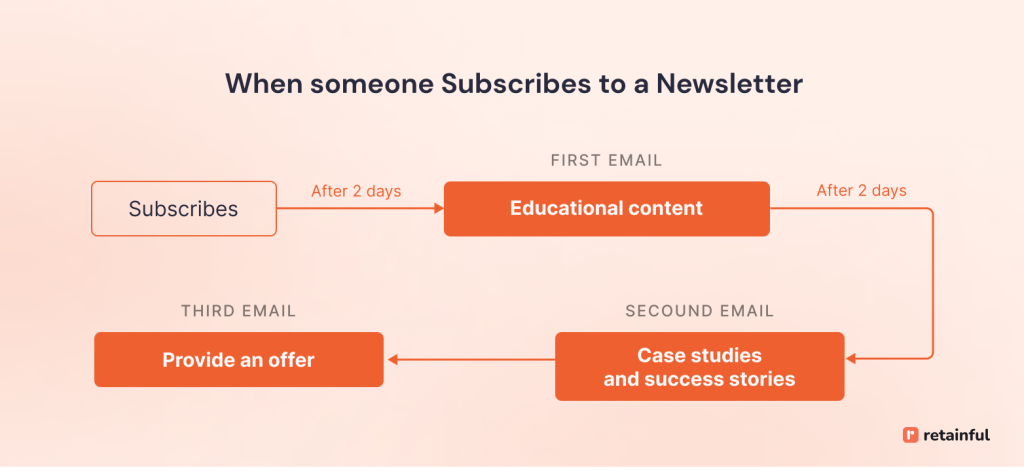
3. Abandoned Cart Series
Abandoned cart emails are sent to users who have added items to their cart but haven’t completed the purchase. Sending multiple emails in a series increases the chances of recovery.
Here is the series of emails to send in this email marketing drip campaign example:
- First email: Simply remind the customer of what they left in their cart.
- Second email: The second email could offer a small discount or free shipping to encourage a purchase.
- Third email: A final reminder might emphasize the limited availability of the cart items to create urgency.
Here is a drip campaign template:
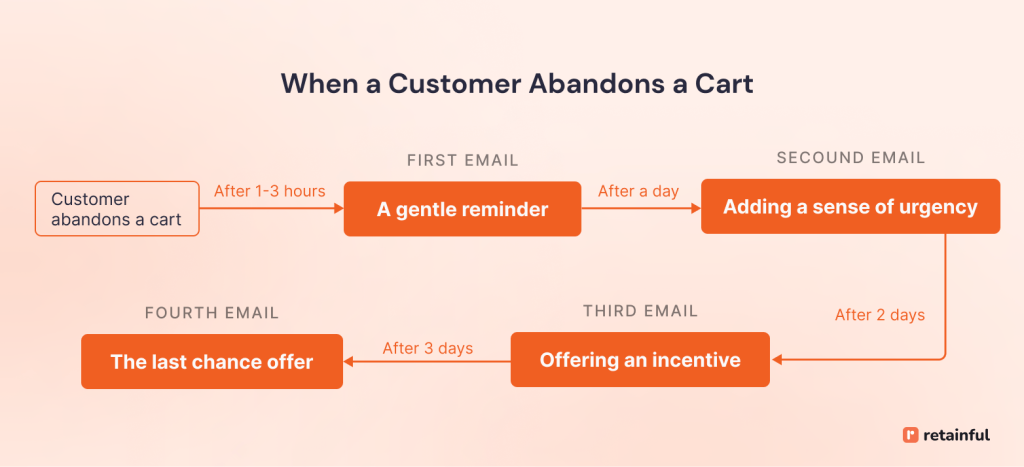
4. Post-purchase follow-up campaign
After a customer makes a purchase, post-purchase follow-up emails can enhance their experience and encourage repeat purchases.
Here is the series of emails to send in this drip email campaign example:
- First email: Thank them for their purchase.
- Second email: Offer helpful information about the product usage or care.
- Third email: Ask for customer feedback or a review.
- Fourth email: Suggest complementary products or accessories.
Here is a drip email campaign workflow:
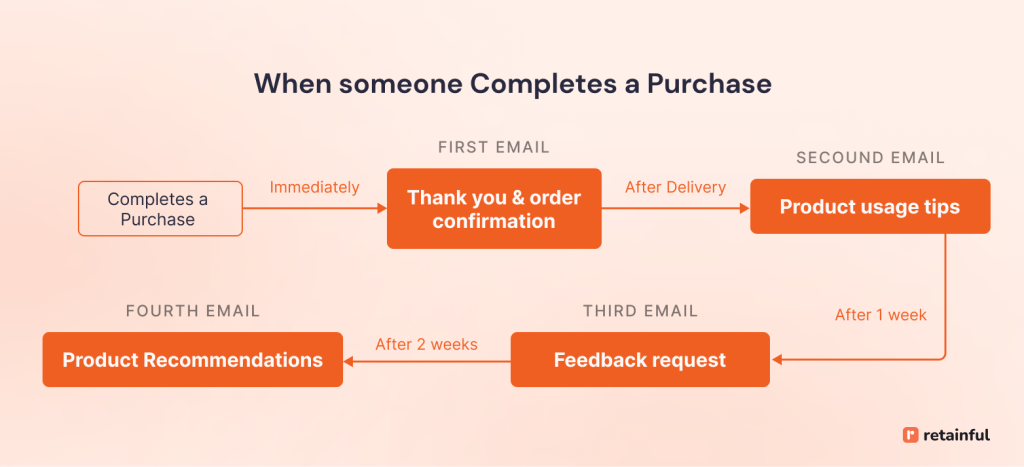
5. Re-engagement series
The re-engagement email marketing drip campaign targets subscribers who have been inactive for an extended period and wins them back to your fold.
Here is the series of emails to send in this drip email campaign example:
- First email: Start with a “We miss you” message and highlight new products or changes since their last visit.
- Second email: Continue with a special offer exclusive to them as a return incentive.
- Third email: Conclude with a feedback request to understand why they disengaged.
Here is a drip email campaign workflow:
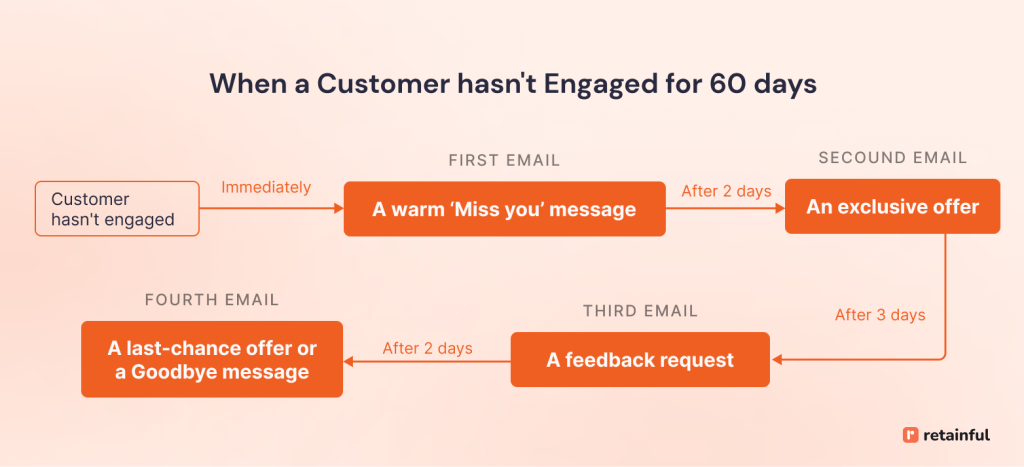
How to Create an Email Drip Campaign?
Creating an email drip campaign can be done in 6 easy steps:
- Step 1: Define your goals
- Step 2: Segment your email list
- Step 3: Map out your campaign
- Step 4: Choose the triggers
- Step 5: Craft your email content
- Step 6: Automate the campaign
Let’s see these steps to create an email drip campaign in detail.
Step 1: Define your goals
Before setting up an email drip campaign, clearly define what you want to achieve.
Are you looking to nurture leads, increase sales, onboard new customers, or re-engage inactive subscribers? Your goals will guide the content, structure, and timing of your campaign.
Step 2: Segment your email list
Segmentation is crucial for the success of automated email drip campaigns.
Divide your email list based on relevant criteria, such as where each subscriber is in the customer journey, demographics, past purchase behavior, or engagement level.
Here are the segmentation criteria you can consider while sending drip campaigns:
- Lead nurturing email campaign: Where the leads originated, how they’ve interacted with your past emails, website, or content.
- Abandoned cart campaigns: By cart value, by product category, frequency of abandonment.
- Post-purchase follow-up campaigns: By purchases items category, by purchase frequency, by purchase value.
- Re-engagement campaigns: By inactivity period, by last interaction.
Launch personalized email campaigns with Retainful’s advanced segmentation and increase your conversion rate.
Step 3: Map out your campaign
Plan the flow of your emails based on the actions that will trigger them. Decide the drip email campaign frequency – how many emails to include in the series and the timing between each one.
This flow should naturally lead the subscriber towards your end goal, whether it’s making a purchase, purchasing the cart items, or another action.
Step 4: Choose the triggers
Decide what actions or behaviors will trigger each email in your automated email drip campaign. Common triggers include:
- Signing up for a newsletter
- Making a purchase
- Abandoning a cart
- Downloading a resource
- Specific dates like birthdays or anniversaries
Step 5: Craft your email content
Write compelling and concise emails that serve the specific purpose of each step in the email campaign workflow.
Ensure each email has a clear call to action (CTA) that encourages the recipient to take the next step. Personalize the emails as much as possible based on the segment to increase relevance and engagement.
Step 6: Automate the campaign
Use email marketing software to automate your drip email campaign. You can implement all the above steps with ease with the best drip email campaign software.
Email Drip Campaign Best Practices
Drip email campaigns allow you to engage and convert leads. To maximize their effectiveness, it’s crucial to employ email drip campaign best practices that ensure each message is targeted, timely, and resonant with your customers.
Here are some of the email drip campaign best practices to follow:
Personalize emails
Once you have segmented your customers, personalization is the email drip campaign best practice to tailor the content of your emails and meet the unique needs and interests of each segment.
This email marketing strategy goes beyond just inserting the recipient’s name in the email. It involves creating content that feels specifically designed for them based on the data you’ve collected.
Choose the right automation platform
Select an email drip campaign software that suits your needs and budget. Look for features like easy-to-setup email automation, advanced segmentation capabilities, integration with other tools, and analytics.
Time your emails strategically
Timing can significantly impact the effectiveness of your drip email marketing campaign. Consider the behavior and time zone of your audience. For example, sending emails based on user activity (like visiting a specific page) can increase relevance and engagement.
Optimize for mobile devices
With more emails being read on mobile devices than ever, ensure your emails are mobile-friendly. This means using responsive design so that your emails look good and function well on any device.
Test and optimize
In this drip email campaign best practice, continuously test different aspects of your emails, including layout, content, subject lines, and sending times. Use A/B testing to compare results and optimize based on what performs best.
Customize your drip email campaign template effortlessly with Retainful’s drag-and-drop email editor and pre-designed email templates.
Wrapping up!!
Done right, an email drip campaign doesn’t just lead to better sales; it creates genuine connections. That’s the real payoff. So, the customer stays with you longer and purchases repeatedly.
By adhering to best practices, personalizing content, and automating them with the best email drip campaign software, you can achieve this.
Choose the right drip email campaign software to create an automated drip email campaign with minimum effort from your end.
Frequently Asked Questions
Drip marketing involves sending a series of automated emails to customers and prospects over time, aiming to build relationships and prompt actions.
An email campaign involves sending one-time emails to a large list, while a drip campaign sends automated, targeted emails based on user behavior or a set schedule.
Both terms often refer to the same concept: a series of automated emails sent at predetermined intervals or triggered by specific user actions.
The duration should align with your marketing goals but typically ranges from a few weeks to several months, depending on the customer’s engagement and the campaign’s purpose.
Success hinges on relevance, personalization, timely delivery, and continuous optimization based on recipient feedback and engagement metrics.
Optimize by A/B testing different elements, segmenting your audience more accurately, refining content based on engagement data, and adjusting timing and triggers.
Structure it by defining the goal, identifying triggers, segmenting the audience, designing a series of emails with clear CTAs, and setting appropriate intervals.
Design by understanding your audience, crafting personalized content, employing eye-catching subject lines, incorporating strong CTAs, and ensuring each email builds on the last.
